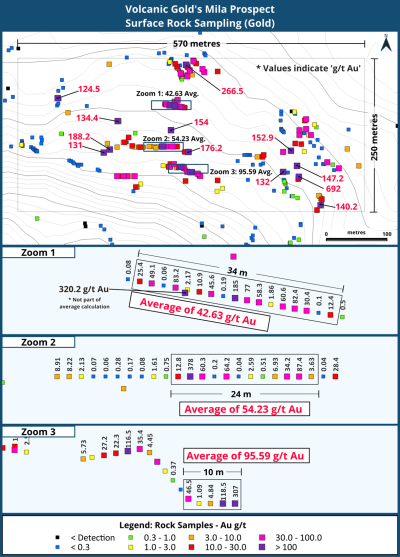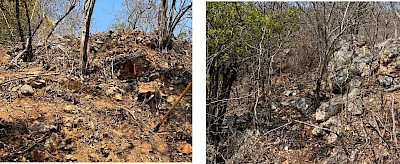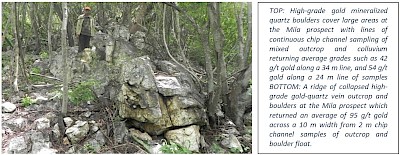Vancouver, British Columbia – Radius Gold Inc. (TSXV: RDU) (“Radius” or the “Company”) is pleased to provide an update on exploration work conducted by JV partner, Volcanic Gold Mines (TSXV-VG), on Radius’s high-grade Mila prospect in the Motagua Norte project in Guatemala.
Highlights of the gold discoveries at the Mila prospect:
- Concentration of bonanza-grade and visible gold in quartz veins over a 250 x 570 m area.
- Continuous line rock chip sampling across mixed outcrop, subcrop, boulder fields of 34 m averaging 42 g/t gold and 24 m averaging 54 g/t gold.
- High-grade gold in both quartz veins and stockwork quartz in the wallrock suggests wide zones of gold mineralization.
- Visible gold in quartz veins identified in new areas to the south and west of Mila.
- Orogenic gold-silver deposit with significant depth potential.
- Trenching and drilling planned to establish the geometry, width and grade of the gold mineralization.
Volcanic’s initial prospecting samples returned exceptional gold grades at Mila prospect (see Radius news release Sept 1, 2022). In order to determine whether the very high gold grades (many samples above 1 oz gold / tonne) were the result of selective sampling or widespread across the target zones, a program of continuous 2 m chip sampling was conducted across mixed terrain of outcrop, subcrop and float boulders. In these areas it is not possible to be sure of true widths, and sampling was conducted to define the distribution of gold mineralization and target trench and drill priorities.
Map of the Cirilo 1 exploration licence showing the location and gold grade of 513 rock chip samples collected during initial prospecting.

High-grade gold assays and visible gold occur in both quartz veins, and in wallrock quartz stockwork zones. Multiple quartz veins with at least two different orientations are recognized; north-south and northwest-southeast striking. The principal mineralized quartz veins form prominent mounds and ridges of collapsed outcrop boulder piles with quartz boulders up to 2 m in diameter and outcrops up to 4 m or more in width. Continuous chip channel sampling across one prominent ridge has returned average grades of up to 95 g/t gold across a 10 m width of collapsed quartz vein boulders, each sample representing a 2 m long segment of the line. Significantly wider quartz boulder fields occur where multiple, close-spaced veins reach surface. Continuous lines of 2 m long chip channel samples of mixed outcrop and colluvium have returned average grades of 42 g/t gold along a 34 m line, and 54 g/t gold over a 24 m line from two parallel lines 70 m apart in one boulder field at the centre of the prospect area.
The distribution of mineralized boulder float, supported by limited outcrop data, suggests that the high-grade gold mineralization in the Mila prospect is concentrated in two north-south structures approximately 200 m apart, each structure at least 250 m strike in length. The current interpretation is that one or both structures support multiple quartz veins across a width of at least 25 to 50 m. Trenching and drilling will be required to look beneath the quartz boulder cover and establish the true geometry, width and grade of the mineralized veins and wallrock stockwork zones in the Mila prospect.
Additional gold vein discoveries
Beyond the Mila prospect ongoing prospecting and rock chip sampling continues to identify additional mineralized veins within the licence area:
- Two gold quartz veins have already been identified approximately 500 m to the south of the Mila prospect with two high-grade rock chip samples of 9.34 g/t and 29.6 g/t gold some 280 m apart.
- Quartz veins grading up to 60.2 g/t gold have also been identified at a couple of locations further along the regional Motagua Norte trend between 800 and 1700 m to the west of the Mila prospect.
Gold mineralization and geology
The mineralized quartz veins and stockwork zones are hosted by biotite schist and phyllite of the Motagua Suture Zone, an east-west striking belt of metamorphic rocks that formed at the line of collision between the North American and Caribbean tectonic plates. Gold mineralization appears to be hosted by north-south and east to southeast-striking veins.
High-grade assays have been returned from both sulphide-bearing quartz veins and quartz stockwork in the wallrock. The mineralized quartz veins are enriched in gold, silver, lead and minor copper and have textures and a geological host consistent with emplacement from a mesothermal system in an orogenic setting. The mineralization appears to be zoned with quartz veins at the eastern end of the licence area at Mila and to the south of Mila containing the highest gold values, and veins to the west of Mila with generally lower gold but higher silver and lead values.
Exploration potential and way forward
The Mila prospect is a new discovery with a sizeable footprint of abundant high-grade quartz at surface, pointing to a significant gold system. The abundance of high-grade quartz vein and quartz stockwork spread across a 250 x 570 m area, the identification of multiple cross-cutting gold mineralized quartz veins at surface, and the demonstration that high-grade quartz is not confined to the quartz veins but also occurs in the wallrock, point to a broad, high-grade and extensive gold system. The mineralization is orogenic style, with mineralization at mesothermal depths within a major transform structure. These systems and structures typically support mineralization over significant vertical distances, and so there is potential for mineralization to continue to significant depths.
Trenching and drilling is planned to map out individual veins, vein sets, and stockwork zones, quantify the width and grade of mineralization, and explore the gold mineralization to depth.
Technical Information
Bruce Smith, M.Sc. (Geology), a member of the Australian Institute of Geoscientists, is Radius’ Qualified Person as defined by National Instrument 43-101 - Standards of Disclosure for Mineral Projects. Mr. Smith has 30 years of mineral exploration experience and has reviewed and approved the technical information contained in this news release.
Radius Gold Inc.
Radius has a portfolio of projects located in Mexico and Guatemala which it continues to advance, utilizing partnerships where appropriate in order to retain the Company’s treasury. At the same time, management is seeking out additional investment and project acquisition opportunities across the globe. Radius is a member of the Gold Group of companies, led by Simon Ridgway. You may find more information on Radius Gold at www.radiusgold.com or www.sedarplus.ca.
ON BEHALF OF THE BOARD
Bruce Smith
President and CEO
Symbol: TSXV-RDU
Contact: Bruce Smith
200 Burrard Street, Suite 650
Vancouver, BC V6C 3L6
Tel: 604-801-5432; Toll free 1-888-627-9378; Fax: 604-662-8829
Email: info@goldgroup.com
Website: www.radiusgold.com
Neither the TSX Venture Exchange nor its Regulation Services Provider (as that term is defined in the policies of the TSX Venture Exchange) acceptsresponsibility for the adequacy or accuracy of this release.
Forward-looking statements
Certain statements contained in this news release constitute forward-looking statements within the meaning of Canadian securities legislation. All statements included herein, other than statements of historical fact, are forward- looking statements and include, without limitation, statements about the results of exploration work and future plans at the Company’s projects. Often, but not always, these forward looking statements can be identified by the use of words such as “estimate”, “estimates”, “estimated”, “potential”, “open”, “future”, “assumed”, “projected”, “used”, “detailed”, “has been”, “gain”, “upgraded”, “offset”, “limited”, “contained”, “reflecting”, “containing”, “remaining”, “to be”, “periodically”, or statements that events, “could” or “should” occur or be achieved and similar expressions, including negative variations.
Forward-looking statements involve known and unknown risks, uncertainties and other factors which may cause the actual results, performance or achievements of the Company to be materially different from any results, performance or achievements expressed or implied by forward-looking statements. Such uncertainties and factors include, among others, whether the planned exploration work at the Company’s projects will proceed as intended; changes in general economic conditions and financial markets; the Company or any joint venture partner not having the financial ability to meet its exploration and development goals; risks associated with the results of exploration and development activities, estimation of mineral resources and the geology, grade and continuity of mineral deposits; unanticipated costs and expenses; and such other risks detailed from time to time in the Company’s quarterly and annual filings with securities regulators and available under the Company’s profile on SEDAR+ at www.sedarplus.ca. Although the Company has attempted to identify important factors that could cause actual actions, events or results to differ materially from those described in forward-looking statements, there may be other factors that cause actions, events or results to differ from those anticipated, estimated or intended.
Forward-looking statements contained herein are based on the assumptions, beliefs, expectations and opinions of management, including but not limited to: that the Company’s stated goals and the planned exploration activities at its properties will be achieved; that there will be no material adverse change affecting the Company or its properties; and such other assumptions as set out herein. Forward-looking statements are made as of the date hereof and the Company disclaims any obligation to update any forward-looking statements, whether as a result of new information, future events or results or otherwise, except as required by law. There can be no assurance that forward-looking statements will prove to be accurate, as actual results and future events could differ materially from those anticipated in such statements. Accordingly, investors should not place undue reliance on forward-looking statements.


